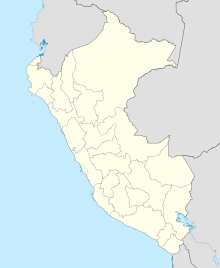Caral
Caral on the map of Peru |
Caral is the oldest known urban settlement on the American continent . The settlement is located in Peru , about 200 km north of Lima and 25 km inland from the Pacific coast in the valley of the mostly dry Río Supe . Since June 2009 Caral-Supe has been part of the UNESCO World Heritage .
history
The age of Caral and its culture was dated on the basis of found reed and cotton nets with the C-14 method to approx. 5000 years and thus belongs to Pre-Ceramic IV-VI of the Andean region , as do the settlements and temples of Salinas de Chao (approx. 3300 BC), La Galgala (approx. 3000 BC) and the somewhat younger Chuquitana . The flowering phase of Caral falls into the so-called "initial phase" (2500–2000 BC), in which the entire central Andean region experienced a great boom, which is also evident from the introduction of ceramics . In terms of time, Caral joins the well-known centers of origin of human civilization alongside Mesopotamia , Egypt and India , but without even approaching the importance of these advanced cultures .
In 1905, the German archaeologist Max Uhle was the first researcher to look into the Caral Valley. He began with excavations in Áspero, a fishing settlement from the time of Caral at the mouth of the Supe River in the Pacific. In 1940, cultural geographer Paul Kosok took aerial photographs of Caral. The Czech-Peruvian archaeologist Ruth Martha Shady Solís has been researching the Caral Valley since 1994 .
architecture
The approximately 620 hectare settlement area of Caral is delimited by six flat, stepped pyramidal elevations, the largest of which is 160 m long, 150 m wide and 18 m high. At the entrance of the pyramid are two 3.50-meter-high monolith of granite ; where the stones come from is not yet clear. The smallest pyramid is approx. 60 m long, 45 m wide and has a height of 10 m. Stones laid in reed pockets were used as foundations, which ensured a stable foundation, especially in the event of an earthquake. The surfaces sunk into the ground are reminiscent of an amphitheater or a cult site.
Cultural background
Fortified structures, trenches or ramparts and weapons, as is otherwise common in Peru, were not found in Caral. Ruth Shady suspects that the coastal areas were regularly hit by devastating floods due to the El Niño weather phenomenon, which drove the inhabitants into the desert area. In fact, the entire valley is criss-crossed by irrigation channels, making it possible to grow pumpkins , beans and other vegetables. Grain seeds have not yet been determined, but cotton seeds ; Cotton was used to make fishing nets.
Given the proximity to the coast (approx. 25 km), the use of sea fish as food is not surprising. To infer from this that Caral's major trading activities or to stylize it as a trading metropolis is inappropriate. The excavations also found fish bones, snail shells and shells from animals that are also found in the Amazon region .
The population of Caral was rather small, it is given at the height of its development with around 1,000. A social stratification can be seen in the differently elaborate styles of the buildings. So far, only a few skeletons have been found in the city . A cemetery has not yet been located. The settlement of the city ended around 1600 BC. Chr .; Reasons for the end are not known. One of the main reasons could be found in the increasing silting up of the settlement area and the coastal lagoons.
literature
- Doris Kurella: Cultures and Buildings of Ancient Peru. History in the backpack (= Kröner's pocket edition . Volume 505). Kröner, Stuttgart 2008, ISBN 978-3-520-50501-9 , ( Caral: Pages 39-47. ).
- R. Shady Solís : Caral - La Ciudad del Fuego Sagrado / The City of the Sacred Fire. Interbank 2004. ( Spanish / English )
- R. Shady Solís, J. Haas, W. Creamer: Dating Caral, a preceramic site in the Supe Valley on the central coast of Peru. In: Science 292 (April 2001), pp. 723-726.
Web links
- Christian Schmidt-Häuer: America's second discovery. Die Zeit , December 17, 2008
- Michael E. Moseley: The Maritime Foundations of Andean Civilization: An Evolving Hypothesis
- The Lost Pyramids of Caral. Transcription of the BBC program Horizon , January 31, 2002 (English)
- Peru: America's oldest city discovered! , GEO , Magazine No. 12/01
Individual evidence
- ↑ Entry on the website of the UNESCO World Heritage Center ( English and French ).
- ^ Kurella 2008: 41
Coordinates: 10 ° 53 ′ 30 ″ S , 77 ° 31 ′ 20 ″ W.




